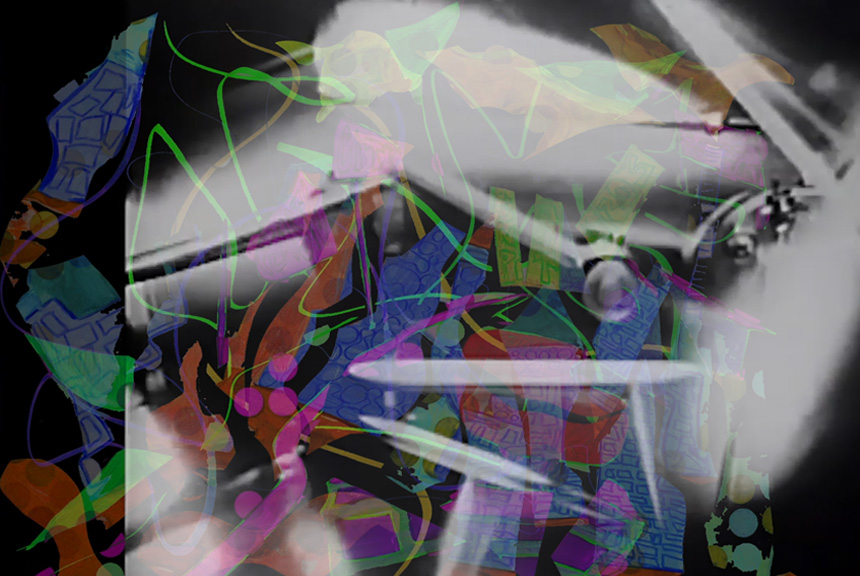Flâneuring in the De_Constructiv Garden
by Heather Coker Hawkins
There is a strangeness seeing five monitors in a glass front gallery space with simultaneous sound emitting from each. The demand on the audience is for them to engage. The viewer must approach a screen to accurately identify a given sound’s source. The individual sound scores themselves are supportive of the visuals and create an intersecting, conflicting and resolving experience unto itself. I experienced Kaz Rahman’s exhibit De_Constructiv Garden Tales (2022 at A+A Gallery 103, University of Tennessee, Knoxville) in solitude, seated on the floor, with my back against the glass. Five precisely positioned monitors are lined up in the middle of a striking cobalt wall to achieve graphic balance. The video monitors are arranged in consideration of shape and color, a painterly organization of space and design. Each emits its own sound score corresponding with its video. When it occurs, the synchronization of sound and video amongst the monitors is purely by chance. I followed the colors, shapes, and movements that attracted my eye. I allowed sound to exist as an ocean of separate entities that ultimately resides together as a symphony of life. My expectation was that I would encounter cacophony with five different audio tracks playing simultaneously. However, the individual scores have been thoughtfully composed so that the pieces compliment and at times, challenge but ultimately resolve with one another. Perhaps it is a palette of sounds with which Hedy Hurban (composer on four of the videos) works that account for the harmony.
Rahman’s De_Constructiv Garden Tales is a collection of works spanning five years. Arranged with intuitive harmony, the works are in constant conversation. The arrangement and presentation of the images are unified by complementary animations, color grading, and digital effects in a similar color palette. Vibrant warm and cool hued shapes and bird silhouettes bounce and cascade across several screens. The natural (birds, plants, organisms) is juxtaposed with the mechanized (human intervention of space and object creation). There is the digital treatment of the image introducing layers, visual obstructions, and graphic movement. Referencing Pop Art, Fernand Léger and early Soviet and Formalist Filmmaking, the objects floating in the foreground or top are not merely layers but exist with their own movement and presence dominating the screen and obscuring the live action more than effect but as content. People and objects, objects and places are considered in the frame together, equal. I imagine a world where instead of living birds swooping into the frame, there are cutout, hand painted renditions flitting through the frame as they will. This approach offers another use of video art- its abstraction of living subjects and places.
There are elements of life on every screen. In the live action footage there is from Left to Right on Monitor 1: a young woman conducting daily life activities; Monitor 2: a touring camera traversing waterways observing birds in flight and architecture; Monitor 3: a stylized spherical view traveling in kaleidoscopic single point forward motion toward city buildings on waterways ever traveling never reaching the destination; Monitor 4: a burlesque circus of performers flying through the air becoming abstracted forms whose movement is noticed and enhanced by the layered painted objects; and Monitor 5: a collection of images of a contented child in nature and a curious child exploring human intervention of space, a building wall seemingly out of place in nature. This content is contrasted by machine age imagery and early 20th century Dadaist film archival footage portraying motion, progress, glorifying mechanization of modern life. This is an attempt to make sense of and find harmony holding in a dialectic the natural world with the mechanized one. Reaching to our histories and “future developments” connecting to the ever-was of pollinators, nature, and people in natural form these works in conversation paint a picture of past fixations of humanity, future visions of traveling toward digital obsolescence all the while reminding us to keep present and protect the beauty of nature. The layers create friction. Taken in with the experience of the past few years, 2020-21, it feels like we are watching a premonition. A healthy woman rendered too tired to arise from her bed. Exterior spaces without people. Children playing, but the pollen-like layer reminds me of a dangerous outside world to many kids harboring allergies.
The circus is also a point of interest that exists as both content and a logic for the composition of the exhibit. Much like Leger’s painting, The Acrobat and His Partner, the two performers represent opposite energetic qualities, in Leger’s words ‘the dynamic and the static’1. In Rahman’s exhibit, the monitors display dynamic movement juxtaposed with slow or still moments. Depictions of everyday people doing everyday things relate back to Leger and his idea that art is for everyone, and anyone can be the subject or beholder of art. There is no velvet rope to prevent some from viewing the work. The same sentiment is present in the way that anyone can access the exhibit and take in the fully intended experience. I find the presentation and matter-of-fact inclusion of everything (all sound and visual elements) to be confident- requesting an active participant to experience the whole collage. Like the collage in each frame, the exhibit itself is a montage to be taken as a whole. This is an invitation to step inside, pay attention, follow interest, lose the thread, and find it again as you form your own meaning and interpretation. For me, I have witnessed a reflection and commentary on where we have been, the choices we have made, and a presentation of each, asking You to consider where we are heading…
Heather Coker Hawkins is a multi-disciplinary artist living in Knoxville, TN (USA)
1 https://www.tate.org.uk/art/artists/fernand-leger-1488/five-things-know-about-fernand-leger


Leave a Reply